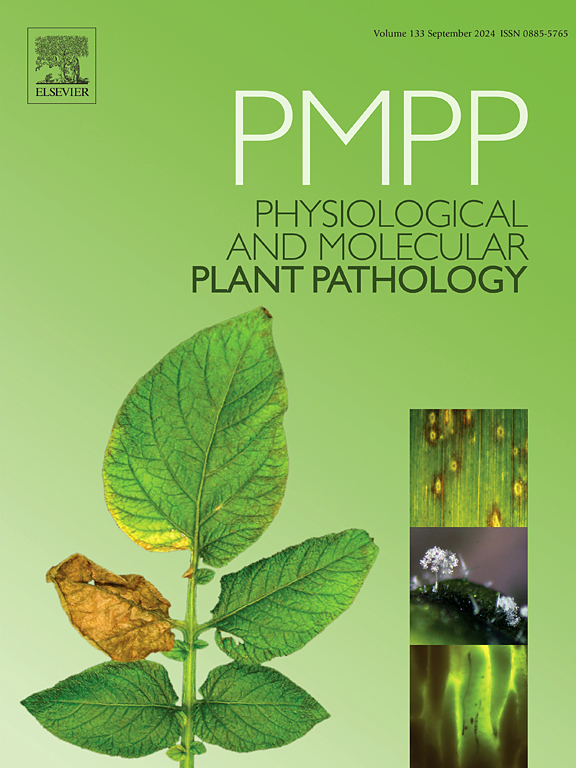Damage threshold and pathogenicity analysis of Meloidogyne javanica on tomato cv. S22 using the seinhorst model
IF 2.8
3区 农林科学
Q2 PLANT SCIENCES
引用次数: 0
Abstract
Root-knot nematodes (RKN) are globally distributed and highly pathogenic. By determining the threshold at which damage occurs, we can create effective measures to protect plants from nematodes. In our study, we investigated the impact of ten initial population densities (Pi-log series) of M. javanica, i.e., 0, 2.38, 2.68, 2.98, 3.28, 3.58, 3.88, 4.18, 4.48 and 4.78 juveniles (J2) g−1 soil on tomato cv. S22 plants in pots. The graphical estimation of yield losses caused by RKN was calculated using Seinhorst's yield loss model based on the relationship between the RKN population and damage to tomato plants. The relationship between initial nematode population density (Pi) and plant yield was analyzed using Seinhorst's model, where T is the tolerance limit, m is the minimum yield, and z is a constant describing yield decline. This allowed us to determine the threshold at which nematode infestation significantly reduces tomato growth. Seinhorst's model, y = m + (1-m) 0.95Pi/T−1 for Pi > T; y = 1 for Pi ≤ T for RKN, was fitted to the data of shoot length and fresh weight of infected and uninoculated control plants to estimate the damage threshold level. The impact of M. javanica on plant physiological parameters, including chlorophyll content, carotenoid and nitrate reductase activity, root-gall formation, and disease incidence, was also determined in this study. The tolerance limits for relative tomato shoot length and fresh weight were 3.34 J2 of M. javanica g−1 soil. The minimum relative values (ym) for shoot length and fresh weights were 0.39 and 0.42, respectively. We found that the damage threshold level was between 3.28 and 3.58. The root galls index, nematode population and reproduction factors were 3.75, 113 and 29.42, respectively, at an initial population density (Pi) of 3.58 J2 g−1 soil. The chlorophyll (0.43 mg g−1), carotenoids (0.06 mg g−1) and nitrate reductase activity (0.21 μmol min−1 g−1). Our study highlights the importance of the accurate estimation of damage thresholds, which can guide timely and effective nematode management strategies.
土曲霉对番茄的危害阈值及致病性分析。S22使用seinhorst模型
根结线虫(RKN)是全球分布的高致病性线虫。通过确定损害发生的阈值,我们可以制定有效的措施来保护植物免受线虫的侵害。研究了0、2.38、2.68、2.98、3.28、3.58、3.88、4.18、4.48和4.78幼虫(J2) g−1土壤)10个初始种群密度(Pi-log序列)对番茄cv的影响。盆栽植物。基于RKN种群与番茄植株危害的关系,采用Seinhorst产量损失模型对RKN造成的产量损失进行图形估计。采用Seinhorst模型分析初始线虫种群密度(Pi)与植株产量的关系,其中T为容忍极限,m为最小产量,z为描述产量下降的常数。这使我们能够确定线虫侵染显著降低番茄生长的阈值。Seinhorst模型,y = m + (1 - m) 0.95π/ T 1−π祝辞T;y = 1, Pi≤T表示RKN,拟合染病和未接种对照植株的茎长和鲜重数据,估计病害阈值水平。本研究还确定了爪哇霉对植物生理参数的影响,包括叶绿素含量、类胡萝卜素和硝酸盐还原酶活性、根瘿形成和疾病发病率。土壤对番茄相对茎长和鲜重的耐受极限为3.34 J2。茎长和鲜重的最小相对值(ym)分别为0.39和0.42。我们发现损害阈值水平在3.28 - 3.58之间。在初始种群密度(Pi)为3.58 J2 g−1时,根瘿指数、线虫种群和繁殖因子分别为3.75、113和29.42。叶绿素(0.43 mg g−1)、类胡萝卜素(0.06 mg g−1)和硝酸还原酶活性(0.21 μmol min−1 g−1)。我们的研究强调了准确估计损害阈值的重要性,这可以指导及时有效的线虫管理策略。
本文章由计算机程序翻译,如有差异,请以英文原文为准。
求助全文
约1分钟内获得全文
求助全文
来源期刊
CiteScore
4.30
自引率
7.40%
发文量
130
审稿时长
38 days
期刊介绍:
Physiological and Molecular Plant Pathology provides an International forum for original research papers, reviews, and commentaries on all aspects of the molecular biology, biochemistry, physiology, histology and cytology, genetics and evolution of plant-microbe interactions.
Papers on all kinds of infective pathogen, including viruses, prokaryotes, fungi, and nematodes, as well as mutualistic organisms such as Rhizobium and mycorrhyzal fungi, are acceptable as long as they have a bearing on the interaction between pathogen and plant.

 求助内容:
求助内容: 应助结果提醒方式:
应助结果提醒方式:


